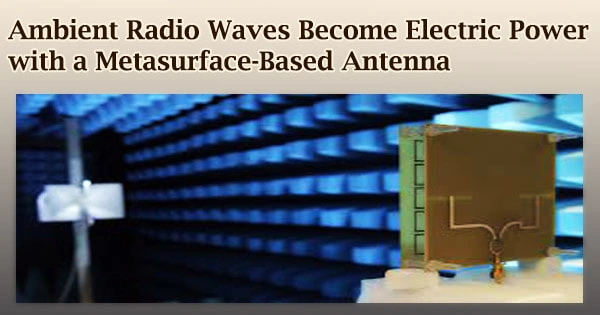Researchers have created a novel metasurface-based antenna that is a significant step toward making it practicable to collect energy from radio waves like those used in cell phone networks or Bluetooth connections. This technique has the potential to deliver wireless power to sensors, LEDs, and other low-energy devices.
“By eliminating wired connections and batteries, these antennas could help reduce costs, improve reliability and make some electrical systems more efficient,” said research team leader Jiangfeng Zhou from the University of South Florida.
“This would be useful for powering smart home sensors such as those used for temperature, lighting and motion or sensors used to monitor the structure of buildings or bridges, where replacing a battery might be difficult or impossible.”
The researchers report in the journal Optical Materials Express that lab testing of their new antenna revealed that it can harvest 100 microwatts of power from low-power radio waves, enough to power modest electronics.
This was made feasible by the antenna’s metamaterial, which has perfect radio wave absorption and was engineered to perform at low intensities.
“Although more work is needed to miniaturize the antenna, our device crosses a key threshold of 100 microwatts of harvested power with high efficiency using ambient power levels found in the real world,” said Clayton Fowler, the team member who fabricated the sample and performed the measurements. “The technology could also be adapted so that a radio wave source could be provided to power or charge devices around a room.”
We also placed a cell phone very close to the antenna during a phone call, and it captured enough energy to power an LED during the call. Although it would be more practical to harvest energy from cell phone towers, this demonstrated the power capturing abilities of the antenna.
Jiangfeng Zhou
Harvesting energy from the air
For a long time, scientists have attempted to collect energy from radio waves, but obtaining enough energy to be useful has proven challenging. This is changing, thanks to metamaterials and the ever-increasing number of ambient radio frequency energy sources, such as cell phone networks, Wi-Fi, GPS, and Bluetooth signals.
“With the huge explosion in radio wave-based technologies, there will be a lot of waste electromagnetic emissions that could be collected,” said Zhou.
“This, combined with advancements in metamaterials, has created a ripe environment for new devices and applications that could benefit from collecting this waste energy and putting it to use.”
Small, carefully constructed structures in metamaterials interact with light and radio waves in ways that natural materials do not.
The researchers employed a metamaterial intended for high absorption of radio waves and that permits a larger voltage to flow across the device’s diode to create the energy-harvesting antenna. This increased its efficiency in converting radio waves into electricity, especially at low intensities.
Testing with ambient power levels
The researchers assessed the amount of power gathered while adjusting the power and frequency of a radio source between 0.7 and 2.0 GHz for lab tests of the device, which measured 16 cm by 16 cm.
They demonstrated the ability to harvest 100 microwatts of electricity from radio waves with an intensity of just 0.4 microwatts per centimeter squared, which is about the same as the strength of radio waves at a distance of 100 meters from a cell phone tower.
“We also placed a cell phone very close to the antenna during a phone call, and it captured enough energy to power an LED during the call,” said Zhou. “Although it would be more practical to harvest energy from cell phone towers, this demonstrated the power capturing abilities of the antenna.”
The researchers are aiming to make the antenna smaller because it is currently far larger than most of the gadgets it may potentially power. They also want to build a version that can collect energy from many types of radio waves at the same time, allowing them to capture more energy.





